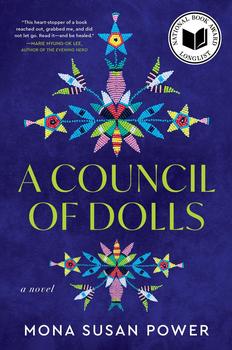Book Club Discussion Questions
In a book club? Subscribe to our Book Club Newsletter and get our best book club books of 2025!
For supplemental discussion material see our Beyond the Book article, Books About Native Residential School Experiences and our BookBrowse Review of A Council of Dolls.
Please be aware that this discussion guide will contain spoilers!
- Sissy's dad says of her beautiful but violent mother: "Your mama is great at fighting
for us, fighting for our community. Sometimes people take their anger and use it in a
good way." How does Sissy's mama channel her rage in a positive way? Does it
compensate for the damage her anger does otherwise?
- What role does Ethel the doll play in Sissy's life? In the final climactic scene of Sissy's
narrative, she hears Ethel say "I took care of it. Somebody had to." How did you
interpret that? Do we gain any additional insight at the end of the book, when we
hear Ethel explain her own version of events?
- As you learned more about Jack's and Lillian's childhoods, did that change your
understanding of who they became as adults? Did you feel differently about them
when you saw them as children versus how you saw them as parents?
- Blanche asks their father, Jack, why he speaks English with her and Lillian, even
though he hates it. He tells her: "Cora and I got into the practice once you started
school, because you didn't understand us so well anymore. We know firsthand how
that works, how you're punished for speaking our language. The constant policing of
our ways and our words interrupts the ability to think fluently. Our thoughts get
chopped up. We don't want that to happen to you." Was this the right decision?
How might things have been different for his children if they had been raised
speaking only Dakhóta?
- Jack tells his daughters: "Maybe English is safer to me because it doesn't mean
anything, because its words are empty to me. No heart. Sometimes when you lose
a lot, you have to put your heart away to keep it ticking." Does this ring true to you?
Do you know people who have experienced similar losses—of language, of culture,
of community?
- Had you heard about America's Indian boarding schools before you read this book?
What new information or perspective did you gain while reading stories of children
who were forced to attend them?
- At the Indian boarding school, Cornelius tells his friends that at the back of a closet
"a cold rush of air brushed our faces and the light clicked on again. Then off. We
heard crying from the darkest corner way in the back." He found scratched on the
closet walls the words "HELP HOME HELP HOME HELP HOME." How did you interpret
that experience? What do the children make of it?
- Why does Lillian feel obligated to give Mae the doll to her dying friend Ada?
How did you interpret Mae's return into Lillian's life even after she was buried
with Ada? Is Mae now a ghost? A figment of Lillian's imagination? A manifestation
of her trauma?
- Winona, Cora's doll, tells her, "Everything I see is colored by my eyes. When they
were sewn of dyed black porcupine quills, the world was dark, and now that
they are indigo glass beads the vision is clear but always twilight. We don't see
the truth. But our heart feels it if we listen." How does this square with what Cora's
mother tells her: "I just want you to know that what strangers make of you means
nothing. Your heart knows the truth"? What ultimately becomes of Winona's heart?
- In the final section of the novel we meet Jesse, in the present day. Why is she
compelled to reunite the dolls that we have seen throughout the story, carried by
her forebears? How did you, the reader, feel as you witnessed each of the dolls reap
pear in Jesse's apartment?
- Who are the three women who appear to Jesse at the end of this story? Why are
they there? Why have they arrived now rather than earlier? How will that experience
inform Jesse's life as she moves forward?
- Author Mona Susan Power based this novel on aspects of her own family's
experiences with Indian boarding schools. She wrote: "The creation of this novel was
both emotionally intense and liberating, and also educational. I was able to see how
generational trauma works, how pain and dysfunction echo in a never-ending
cycle of various kinds of abuse until someone finally heals." What form does the
healing take in this novel? How do we know that it's happened? Have you seen
examples of this kind of healing from trauma in your own life?
RESOURCES FOR FURTHER READING
The National Native American Boarding School Healing Coalition https://boardingschoolhealing.org/
American Indian Stories, Legends, and Other Writings by Zitkala-Ša (Penguin Classics, 2003)
Boarding School Seasons: American Indian Families, 1900-1940 by Brenda J. Child (Univ. of Nebraska
Press, 2000)
Indian School Days by Basil H. Johnston (Univ. of Oklahoma Press, 1990)
Kuper Island, podcast about the experiences of Indigenous children at a residential school in Canada
(CBC Podcasts, 2022) https://www.cbc.ca/radio/podcastnews/kuper-island-transcripts-listen-
1.6622551
Stringing Rosaries: The History, the Unforgivable, and the Healing of Northern Plains American Indian
Boarding School Survivors by Denise K. Lajimodiere (North Dakota State Univ. Press, 2019)
They Called It Prairie Light: The Story of Chilocco Indian School by K. Tsianina Lomawaima (Univ. of Nebraska Press, 1995)
They Called Me Number One: Secrets and Survival at an Indian Residential School by Bev Sellars (Talonbooks, 2012)
Download the full book club kit
Unless otherwise stated, this discussion guide is reprinted with the permission of Mariner Books.
Any page references refer to a USA edition of the book, usually the trade paperback version, and may vary in other editions.
